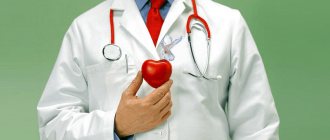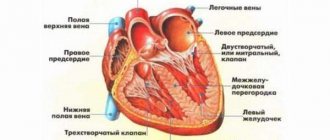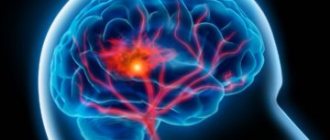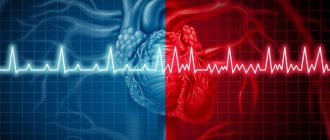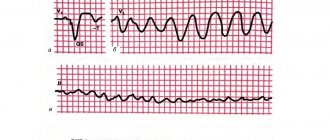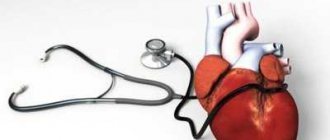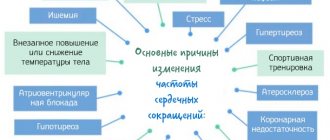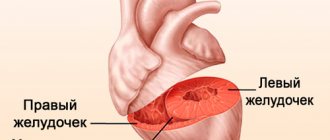The most unfavorable form of arrhythmia is supraventricular chaotic contraction. Due to the high risk of thromboembolism, atrial fibrillation should be treated immediately. Additionally, attention is paid to anti-relapse therapy.
Atrial fibrillation (AF) most often develops against the background of acute and chronic heart failure. Its occurrence significantly complicates hemodynamics and reduces the prognosis to unfavorable. A relationship between the incidence of fibrillation and the increase in the functional class of heart failure was noted. The higher the latter, the greater the risk of developing AF (with FC II the risk is 10%, with FC IV – almost 40%).
The presence of cardiovascular pathology increases the likelihood of atrial fibrillation. If in clinically healthy people the incidence rate is 1.6%, then in the presence of heart and vascular diseases it increases to 9.1%.
Stopping attacks is important in providing first aid to a patient. Also, over the years, experience has been collected in the treatment of atrial fibrillation of the heart. Today, various strategies and methods of treating AF, which is combined with both chronic heart failure and other diseases of the cardiovascular system, are used in practice.
Video Atrial fibrillation: causes, treatment
What it is
Normal work of the heart muscle is the contraction of the atria and ventricles in the correct sequence . When there are disturbances, the heart begins to contract in the wrong rhythm, so the medical name for this phenomenon is arrhythmia.
The most common type of disease in people is atrial fibrillation. In this case, the phase in which the atria contract disappears .
Instead of contractions, twitching or “flickering” occurs, which affects the functioning of the ventricles.
Why is atrial fibrillation so dangerous?
Atrial fibrillation is the most common heart rhythm disorder, which in itself does not threaten human life. Moreover, there is even something like a joke among doctors when they talk about atrial fibrillation. But why then do doctors sound the alarm when identifying atrial fibrillation?
Atrial fibrillation is dangerous with complications! Atrial fibrillation is the most common heart rhythm disorder, which in itself does not pose a threat to human life. Frequent contractions of the two upper chambers of the heart, that is, the atria, following each other without interruption, have little effect on the general blood circulation. The ventricles continue to contract as usual and pump blood through the vessels, delivering oxygen and nutrients to all corners of the body. Violation of the rhythm of atrial contraction extremely rarely leads to a malfunction of the ventricles, which actually poses the greatest threat to life
Why then does atrial fibrillation attract such close attention from doctors? What is its danger to humans?
What's flickering there and why?
Atrial fibrillation, or atrial fibrillation, as it is also called, is characterized by frequent chaotic contraction of the atria, reaching a frequency of 350-700 beats per minute. In fact, the two upper parts of the heart, supplying blood to the ventricles, stop contracting; only twitching of individual fibers of the heart muscle is noted. Blood enters the ventricles by gravity, and the ventricles continue to work at their own rhythm, contracting much less frequently than the atria.
The causes of atrial fibrillation lie in defects in the functioning of the pacemaker, which is responsible for the coordinated contraction of the heart. In disruption of the conductivity of fibers that deliver nerve impulses from the pacemaker to the myocardium, in increased excitability of the heart muscle, which responds with contraction to these impulses. All this is quite difficult for an ordinary person; it is more important to know that stress, smoking, drinking alcohol and abusing products containing caffeine can lead to heart rhythm disturbances. Even a banal viral infection can cause problems with the heart, not to mention hypertension, diseases of the heart, lungs and thyroid gland.
Every 200th inhabitant of the Earth suffers from atrial fibrillation, and the older the person, the higher the risk of developing arrhythmia. In people aged 50-60 years, atrial fibrillation occurs with a frequency of 3.5%, and among 80-90 year olds, almost every tenth person has rhythm disturbances. It is interesting that women suffer from arrhythmia less often than men, but in them the rhythm disturbance is more severe and difficult to correct.
Atrial fibrillation, although it does not directly threaten a person’s life, significantly reduces the quality of life. It is enough to look at its symptoms to be convinced that life with arrhythmia is far from easy. The “inactivity” of the atria leads to the fact that little blood enters the ventricles, which means that general blood circulation suffers and the functioning of the entire body is disrupted.
The most distinct symptoms of atrial fibrillation:
cardiopalmus;
dizziness or fainting;
sweating;
feeling of lack of air;
panic fear for one's own life;
frequent urination.
Attacks of atrial fibrillation can be rare or frequent, sometimes rhythm disturbances are permanent and then they must be treated.
Why is atrial fibrillation dangerous?
In half of the cases, atrial fibrillation does not affect the general condition of the patients, the attacks go unnoticed, but this does not detract from the danger of the disease. The thing is that the lack of coordinated contraction of the atria leads to stagnation of blood in them and is fraught with the formation of blood clots - thrombi. From the atria, blood clots enter the ventricles, then are carried into the arteries of the brain and other vital organs, causing acute circulatory disorders in them.
Atrial fibrillation is considered one of the main causes of cerebral strokes. It is believed that the presence of this heart rhythm disorder increases the risk of brain catastrophe resulting in death or disability by 5 times.
Once in the coronary artery system, the thrombus causes the development of myocardial infarction.
Once in the blood vessels of the intestine, the thrombus becomes the cause of its gangrene and the development of severe peritonitis, often fatal.
Doctors believe that for severe complications to develop, it is enough for an attack of atrial fibrillation to continue for 2 days. Moreover, according to statistics, up to 30% of asymptomatic attacks last much longer. This is where the main threat lies, the most common heart rhythm disorder on Earth.
Prevalence
The disease has been known for quite some time, and according to statistics, every two hundredth visitor to the clinic is diagnosed with heart rhythm disturbances.
Often, atrial fibrillation (AF) appears as a consequence and complication of coronary artery disease or hypertension.
AF includes both atrial flutter and fibrillation.
Various studies of this disease have been carried out in the UK and USA, which show that this disease occurs in 0.4 – 0.9% of the adult population .
An attack of AF is usually pronounced at the beginning, then relapses begin to occur (periodic ejection of blood into the aorta).
Doctor's advice
I think there is no need to talk about lifestyle modification, which can reduce the risk of obesity, diabetes and arterial hypertension. But many people forget that, having a family history of arrhythmia, it is necessary to promptly treat all diseases of the lungs and bronchi, choose a profession wisely, avoiding work with a high content of dust in the air (for example, the mining industry). This will reduce the risk of fibrillation associated with COPD.
Classification, differences between species, stages
The disease has 3 stages:
- Stops without any treatment . It does not pose any particular danger and has a favorable prognosis.
- Doesn't stop on its own . Heart rhythm is restored due to medication or physiotherapy.
- Constant . There is a need to constantly monitor heart function to avoid thromboembolism.
There are several forms of cardiac rhythm disturbances.
These include: a form with an undisturbed ventricular rhythm, a form with wide QRS complexes, and a bradysystolic form. Atrial fibrillation can be paroxysmal (paroxysmal) and permanent (long-term); the treatment for both forms is similar.
Treatment methods for atrial fibrillation
For treatment, first of all, it is necessary to find out the main cause of atrial fibrillation, and if it is caused by any systemic disease or another previous cardiac disease, then it is necessary to start with its treatment. It is quite possible that with this treatment regimen, atrial fibrillation will go away without intensive targeted treatment.
If you need to take sedatives, you need to choose them wisely in order to stop panic attacks and anxiety without aggravating heart problems. Therapy and a diet high in potassium and magnesium are also prescribed, and drug intervention may be indicated.
Surgical intervention for arrhythmia is usually not used in medical practice and does not have any significant advantages over medication (in this context). It is advisable to completely give up smoking, fatty, caffeine-containing and alcoholic meals.
If the disease is already chronic, then you will have to take appropriate medications for the rest of your life - of course, under the supervision of a doctor. You should not interrupt the course of treatment without a doctor’s advice, even if there are improvements and significant alignment of the heart rhythm.
Why it occurs, risk factors in young and elderly people
Most often, this disease of the heart muscle occurs as a result of rheumatic damage, as well as obesity or diabetes (mellitus), myocardial infarction (find out what it is and what the consequences are), and alcohol damage.
It affects the heart muscle and taking various medications, smoking, strong psycho-emotional stress, frequent consumption of caffeinated drinks - coffee, strong tea, energy drinks.
Heart surgeries and congenital heart defects can also be considered risk factors.
Most episodes of MA disease occur in elderly patients— over 75 years of age . Not everyone can accurately determine the cause of this disease.
Cardiac pathology is one of the most common causes. This disease often occurs if the patient has ever been diagnosed with diseases or disorders of the thyroid gland.
A risk factor for young people is bad habits. Drinking alcohol in unlimited quantities and smoking greatly increase the likelihood of developing MA.
Surgical treatment of atrial fibrillation
Drug treatment for AF in some cases is not effective enough, which directs treatment in a more radical direction.
Non-pharmacological methods of controlling heart rate include the following types of surgery:
- Radiofrequency ablation. It is based on the introduction of a catheter through the femoral vein, which modifies the atrioventricular connection.
- Operation “labyrinth”. Helps restore sinus rhythm in 85% of cases. It consists of performing surgical intervention on the tissue of the atria in order to reduce the mass of the heart muscle involved in the formation of an ectopic focus through the re-entry mechanism.
- Implantation of an atrial cardioverter-defibrillator. They have high specificity (almost 100%) and recognition (up to 92%) of paroxysmal attacks of AF. The devices effectively stop the development of attacks, but are suitable only for those patients who experience rare paroxysms.
In some cases, cardiac pacing is indicated. It is often used for persistent and paroxysmal atrial fibrillation. ECS is also used after open heart surgery to reduce the risk of recurrence of arrhythmia.
Symptoms and signs of an attack
How does arrhythmia manifest? This depends on the form in which the disease occurs, as well as on the characteristics of the person’s psyche and the general condition of the myocardium.
The initial signs of this heart disease include periodic shortness of breath, which does not stop for a long time after playing sports, rapid heartbeat, pain or other unpleasant sensations. All this occurs in the form of attacks.
Not everyone develops the disease into a chronic form. Seizures may begin and recur occasionally throughout life . In some patients, 2 or 3 attacks of atrial fibrillation become chronic. Sometimes the disease is detected only after a thorough medical examination.
Symptoms also include: sudden palpitations, weakness throughout the body, trembling, increased sweating, a feeling of fear and fainting.
Find out more useful information about this disease in simple language from the video:
Causes of the disease and genetic aspects
I would like to note that it is very important to distinguish the true cause of atrial fibrillation from factors that only contribute to the manifestation of the disease.
The pathology is based on a genetic mutation, a kind of “breakdown”. Even in the absence of associated cardiovascular risks, the chance of developing atrial fibrillation in patients with such a DNA defect is very high.
At the moment, about 14 variants of changes in the genotype are known that lead to rhythm disturbances. The most common and significant mutation is believed to be located on chromosome 4q25.
In this situation, a complex disruption of the structures and functions of the atrial myocardium occurs - its remodeling occurs.
In the future, it is planned to resort to the help of genomic analysis, which will improve the prognosis of the disease and reduce disability through early diagnosis of pathology and timely treatment.
Diagnostics
To make a correct diagnosis of heart muscle disease, the following diagnosis is carried out: the patient is asked to perform some physical exercise, then an ECG procedure is used .
If the form is bradysystolic, then when the muscles are loaded, the rhythm increases greatly. Differential diagnosis is often carried out with sinus tachycardia.
Signs of atrial fibrillation on the ECG:
Clinical case
Patient A., 25 years old, was brought to the emergency department with complaints of lack of air, inability to breathe deeply, palpitations, dizziness, and severe general weakness.
The patient was engaged in semi-professional powerlifting, and during the next approach he lost consciousness. In the family, the grandmother and mother were diagnosed with atrial fibrillation. Objectively: the skin is pale, shortness of breath at rest, blood pressure is 90/60 mm Hg, heart rate on auscultation is 400 beats/min, the first tone is also heard louder than normal, the rhythm is irregular, the pulse on the radial artery is 250 beats/min. Preliminary diagnosis: “Newly diagnosed atrial fibrillation.” To confirm the diagnosis, the following were used: clinical blood and urine tests, determination of TSH levels, ECG, Echo-CG. The patient underwent pharmacological cardioversion with Dofetilide, after which sinus rhythm was restored with a heart rate in the range of 60-64 beats/min. During the hospital stay, 24-hour ECG monitoring was carried out, and no paroxysms of fibrillation were observed. The patient was advised to limit physical activity.
First and emergency aid for paroxysm
To avoid attacks, you should remember to take medications prescribed by your doctor that calm your heart rate.
The first thing you can do to help yourself or others during an attack of atrial fibrillation is to call an ambulance . If this often happens to you personally, carry the pills prescribed by your doctor with you. Usually these are valerian tablets, validol or volocardin.
If the place is crowded, then ask those around you if they have medicine. If the pressure drops sharply, the lungs begin to swell, and a state of shock occurs.
What can be done, treatment tactics, medications
How to treat atrial fibrillation? First of all, it depends on the form of the disease. Treatment of atrial fibrillation can be medicinal and surgical (operative).
The main goal is to restore and maintain sinus rhythm , control the heart rate and avoid thromboembolic complications after illness.
One of the most effective means is the introduction of novocainamide into a vein or inside, as well as cordarone or quinidine .
Propanorm is also prescribed , but before this you should monitor your blood pressure and monitor the electrocardiogram readings.
There are less effective medications. These most often include anaprilin, digoxin or verapamil . They help get rid of shortness of breath and weakness in the body and rapid heartbeat.
If medications do not provide any results, then cardioversion becomes necessary. During this procedure, an electrical charge is sent to the heart area and thus the heart rhythm is restored. In most cases this helps the patient very well.
You can see how electrical cardioversion is performed for atrial fibrillation in the video (in English):
If MA lasts more than two days, then the patient is prescribed warfarin . This drug prevents the development of thromboembolic complications in the future.
The most important thing is to treat the underlying disease that led to heart rhythm disturbances.
There is also a method that allows you to eliminate atrial fibrillation in a radical way. This is radiofrequency isolation of the pulmonary veins . In 60% of cases the method helps.
Sometimes traditional treatments help. These include taking a decoction of hawthorn and valerian .
Treatment of atrial fibrillation in pregnant women
AF is associated with various heart diseases - defects (congenital and acquired), myocarditis, coronary circulatory disorders. If pregnancy develops against the background of these diseases, there is a high probability of developing atrial fibrillation. If this pathology occurs, the patient is treated in accordance with the recommendations of the European Society of Cardiology from 2010, as well as later revisions, for example, 2014 and 2020.
Anticoagulant therapy is important during the treatment of AF. It is mandatory for pregnant women with this pathology. The only thing is that blood thinners should be taken with caution in the first trimester and a month before the expected date of birth. During these periods it is better to use heparin.
New oral anticoagulants (rivaroxaban, dabigatran, apixaban) should not be used in the treatment of pregnant women. Also, these drugs should not be prescribed during pregnancy planning.
Rehabilitation
When the attacks of arrhythmia are removed, the heart is functioning properly and the patient is allowed to go home, it is necessary to undergo rehabilitation, which includes a full range of preventive measures .
The first thing you should pay attention to in case of atrial fibrillation is adjusting the nutritional system and maintaining a diet. You should try to minimize your intake of saturated fats, such as butter, and salt.
A heart patient needs foods that contain a lot of potassium , and salt is an antagonist.
You need to include in your daily diet not only bananas, which contain a lot of potassium, but also foods such as baked potatoes, dried apricots, blueberries, and apricots.
To lower cholesterol levels, you should add bran to your food. It is also necessary to focus on greens and garlic, which perfectly cleanses blood vessels.
To reduce the negative impact of a respiratory arrhythmia, you need to pay attention to your breathing . Difficulty breathing worsens the general condition, as a result of which the body becomes oversaturated with carbon dioxide. To normalize the respiratory vessels, you should try breathing according to the Buteyko system.
Find out how to breathe correctly using the Buteyko system from the video:
Proper breathing allows you to avoid vascular spasms and is an excellent prevention of atrial fibrillation. Many patients benefit greatly from walking as a form of rehabilitation.
Treatment of atrial fibrillation with folk remedies
During drug therapy for AF, especially with infrequent manifestations, it is recommended to additionally use herbal medicine. The collection of folk recipes contains many plants that can cope with arrhythmias and other cardiovascular diseases. The following folk remedies are most often used:
- Viburnum berries are rich in heart-healthy substances, so its use can improve the well-being of patients with atrial fibrillation. A decoction is made from dried fruits; take one glass of it and pour the same volume of hot water. Next, boil a little over medium heat and, after cooling, take three times a day in equal portions.
- Hawthorn berries are a valuable fruit for the heart and blood vessels, so tinctures are made from them, which are taken before meals with a small amount of water, 20-30 drops.
- Dill seeds are rich in those components that are necessary for the heart. To prepare the decoction, take ⅓ of the seeds and pour a glass of boiling water, then wrap it up to infuse. Take in equal parts three times a day before meals.
Video Heart Facts. Atrial fibrillation
Despite the danger of atrial fibrillation, with proper treatment, the prognosis for the disease is favorable. The main thing is not to despair and, after medical consultation, follow the prescribed recommendations with faith in their success.
3.60 avg. rating ( 73 % score) – 10 votes – ratings
Life prognosis, complications and consequences
Most complications occur as a result of the fact that patients do not follow the full instructions of doctors and begin to be treated chaotically, at their own discretion.
Difficulty breathing, anxiety, discomfort or pain in the chest, tachycardia are reasons to consult a doctor to avoid complications in the future.
Is it possible to completely cure atrial fibrillation? Complete cure depends on various factors and the form of the disease.
A timely visit to a cardiologist and carrying out all diagnostic tests will help identify this disease at an early stage. One of the dangers resulting from a diagnosis of atrial fibrillation is the formation of blood clots in the vessels .
If the attacks appear suddenly and disappear within two days, then the prognosis is favorable .
If the disease has become chronic and lasts for two weeks or more, then special therapy is necessary. Timely relief of an attack affects the overall outcome. You should visit a cardiologist periodically to monitor the progression of the disease.
If MA is not treated, the outcome is extremely poor . Failure of the atria can worsen the course of the patient's underlying disease.
More about the dangers of atrial fibrillation and methods to prevent consequences:
Preparing for your appointment
If you think you may have atrial fibrillation, it is important that you make an appointment with your GP. If atrial fibrillation is caught early, your treatment may be easier and more effective. However, you may be referred to a doctor trained in the heart (cardiologist).
Because meetings can be brief, and because there is often a lot to discuss, it is a good idea to prepare for the meeting. Here's some information to help you prepare for your appointment and what to expect from your doctor.
What can you do
- Be aware of any prior restrictions. At the time you make your appointment, be sure to ask if there is anything you need to do in advance, such as limiting your food intake. You may need to do this if your doctor orders blood tests.
- Write down all the symptoms you experience, including any that may seem unrelated to atrial fibrillation.
- Write down key personal information, including a family history of heart disease, stroke, high blood pressure or diabetes, as well as any major stresses or recent life changes.
- Make a list of all the medications, vitamins, or supplements you take.
- Take a family member or friend if possible. Sometimes it can be difficult to understand and remember all the information given to you during an appointment. Someone accompanying you may remember what you missed or forgot.
- Write down questions to ask your doctor.
Your time with your doctor is limited, so preparing a list of questions will help you make the most of your time. List your questions from most important to least important if time runs out. For atrial fibrillation, some basic questions to ask your doctor include:
- What could be causing my symptoms or condition?
- What are other possible causes of my symptoms or conditions?
- What tests do I need?
- What is the most appropriate treatment?
- What foods should you eat or avoid?
- What is the appropriate level of physical activity?
- How often should I be screened for heart disease or other complications of atrial fibrillation?
- What are the alternatives to the primary approach you propose?
- I have other health conditions. How can I better manage them together?
- Are there any restrictions that I need to adhere to?
- Should I see a specialist? What will it cost and will my insurance cover the seeing specialist? (You may need to contact your insurance provider directly for coverage information.)
- Is there a generic alternative to the medication you are prescribed?
- Are there any brochures or other printed materials that I can take home with me? What sites do you recommend visiting?
In addition to the questions you are prepared to ask your doctor, don't hesitate to ask questions during your appointment.
Relapse prevention and prevention measures
Attacks of this disease can be difficult for the patient to tolerate and make his life very difficult. Therefore, you should take care of your health in advance. First of all, the main diseases should be treated in a timely manner - coronary heart disease, tachycardia and others.
It is advisable not to refuse hospitalization if the doctor insists on your stay there. It is best if the prevention of arrhythmia occurs under the supervision of a doctor.
If you periodically have problems with the cardiovascular system, do an electrocardiogram at least once a month to track the slightest changes in the functioning of the heart muscle.
If sinus rhythm is not restored after taking medications for a long time, the doctor determines that the disease has become permanent. In such cases, he prescribes other medications.
You should follow a balanced diet and not eat a lot of fatty foods , which can lead to the appearance of underlying diseases, and then atrial fibrillation.
You should also reduce negative habits to a minimum - reduce alcohol consumption, stop smoking.
If you have atrial fibrillation, be sure to give your body physical activity and control your lifestyle. Even ordinary walking for a long time is an excellent prevention of atrial fibrillation. Maintain your weight at a normal level and monitor your blood sugar levels.
Procedures to reduce the risk of stroke
Some people have untreatable atrial fibrillation, the symptoms of which can be difficult to control. In such situations, doctors tend to focus on treatment options that reduce the risk of stroke.
Left atrial appendage closure is a procedure that seals off an area of the heart called the left atrial appendage (LAA). The LAA is a small sac located on the upper left side of the heart, in close proximity to the upper left ventricle of the heart. The LAA is the area of the heart where blood accumulates the most during episodes of atrial fibrillation. When blood pools in the LAA, blood clots can begin to form there, forming blood clots.
If at least one blood clot bypasses the LAA, floats with the bloodstream through the arteries and enters the brain, an ischemic stroke may occur. A stroke is an emergency that requires immediate medical attention to restore proper blood flow to the brain. Depending on how severe the stroke is or how long the brain does not receive enough nutrition, the condition can lead to disability or even death.
The purpose of LAA closure is to completely seal it so that blood cannot enter or escape from the LAA. There are various methods for closing the left atrial appendage, including tightening the left atrial appendage using a lasso tool or implanting a tiny device (WATCHMAN or AMPLATZER Cardiac Plug). Both of these procedures are considered minimally invasive, meaning that the patient does not undergo open-heart surgery.
